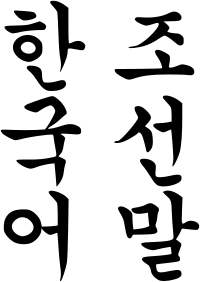
Back Акореиа бызшәа Abkhazian Koreaans Afrikaans Koreanische Sprache ALS ኮሪይኛ Amharic Idioma coreano AN कोरियाई भाषा ANP اللغة الكورية Arabic لغه كورى ARZ কোৰীয় ভাষা Assamese Idioma coreanu AST
| Korean | |
|---|---|
| 한국어, 조선말 Hangugeo, Chosŏnmal | |
 Two names for Korean, Hangugeo and Chosŏnmal, written vertically in hangul | |
| Native to | South Korea North Korea Jilin·Liaoning·Heilongjiang, China |
Native speakers | 76 million (2007)[1] |
Koreanic
| |
Early forms | Old Korean
|
| Dialects |
|
| Hangul (primary) Hanja (mixed script) Korean Braille Cyrillic (Koryo-mar) | |
| Official status | |
Official language in | |
| Regulated by | South Korea: The National Institute of the Korean Language 국립국어원/ 國立國語院 North Korea: Sahoe Kwahagwon Ŏhak Yŏnguso The Language Research Institute of Social Science 사회과학원 어학연구소/ 社會科學院 語學研究所 |
| Language codes | |
| ISO 639-1 | ko |
| ISO 639-2 | kor |
| ISO 639-3 | Variously:kor – Modern Koreanokm – Middle Koreanoko – Old Korean |
okm Middle Korean | |
oko Old Korean | |
| Glottolog | kore1280 |
| Linguasphere | 45-AAA-a |
 Countries with native Korean-speaking populations. (Established immigrant communities in green) | |
The Korean language is spoken mainly in North and South Korea. It is spoken by more than 78 million people (most are North or South Koreans).
- ↑ Nationalencyklopedin "Världens 100 största språk 2007" The World's 100 Largest Languages in 2007